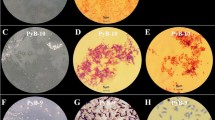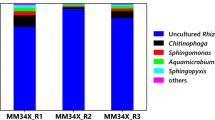Abstract
Polycyclic aromatic hydrocarbons (PAHs) often occur in oil-contaminated soil, coke wastewater and domestic sludge; however, associated PAH degraders in these environments are not clear. Here we evaluated phenanthrene degradation potential in the mixed samples of above environments, and obtained a methanogenic community with different microbial profile compared to those from sediments. Phenanthrene was efficiently degraded (1.26 mg/L/d) and nonstoichiometric amount of methane was produced simultaneously. 16S rRNA gene sequencing demonstrated that bacterial populations were mainly associated with Comamonadaceae Nocardiaceae and Thermodesulfobiaceae, and that methanogenic archaea groups were dominated by Methanobacterium and Methanothermobacter. Substances such as hexane, hexadecane, benzene and glucose showed the most positive effects on phenanthrene degradation. Substrate utilization tests indicated that this culture could not utilize other PAHs. These analyses could offer us some suggestions on the putative phenanthrene-degrading microbes in such environments, and might help us develop strategies for the removal of PAHs from contaminated soil and sludge.

Similar content being viewed by others
References
Aislabie J, McLeod M, Fraser R (1998). Potential for biodegradation of hydrocarbons in soil from the Ross Dependency, Antarctica. Applied Microbiology and Biotechnology, 49(2): 210–214
Bengtsson G, Zerhouni P (2003). Effects of carbon substrate enrichment and DOC concentration on biodegradation of PAHs in soil. Journal of Applied Microbiology, 94(4): 608–617
Berdugo-Clavijo C, Dong X, Soh J, Sensen C W, Gieg L M (2012). Methanogenic biodegradation of two-ringed polycyclic aromatic hydrocarbons. FEMS Microbiology Ecology, 81(1): 124–133
Canul-Chan M, Sánchez-González M, González-Burgos A, Zepeda A, Rojas-Herrera R (2017). Population structures shift during the biodegradation of crude and fuel oil by an indigenous consortium. International Journal of Environmental Science and Technology, 15(1): 1–16
Chang B V, Chang I T, Yuan S Y (2008a). Anaerobic degradation of phenanthrene and pyrene in mangrove sediment. Bulletin of Environmental Contamination and Toxicology, 80(2): 145–149
Chang B V, Chang S W, Yuan S Y. Anaerobic degradation of polycyclic aromatic hydrocarbons in sludge. Adv Environ Res, 2003, 7(3): 623–628
Chang B V, Shiung L C, Yuan S Y. Anaerobic biodegradation of polycyclic aromatic hydrocarbon in soil. Chemosphere, 2002, 48: 717–724
Chang M W, Holoman T P, Yi H (2008b). Molecular characterization of surfactant-driven microbial community changes in anaerobic phenanthrene-degrading cultures under methanogenic conditions. Biotechnology Letters, 30(9): 1595–1601
Chang W, Um Y, Hoffman B, Pulliam Holoman T R (2005). Molecular characterization of polycyclic aromatic hydrocarbon (PAH)-degrading methanogenic communities. Biotechnology Progress, 21(3): 682–688
Chang W, Um Y, Holoman T R (2006). Polycyclic aromatic hydrocarbon (PAH) degradation coupled to methanogenesis. Biotechnology Letters, 28(6): 425–430
Chen S, Aitken M D (1999). Salicylate stimulates the degradation of high-molecular weight polycyclic aromatic hydrocarbons by Pseudomonas saccharophila P15. Environmental Science & Technology, 33(3): 435–439
Davidova I A, Gieg L M, Duncan K E, Suflita J M (2007). Anaerobic phenanthrene mineralization by a carboxylating sulfate-reducing bacterial enrichment. ISME Journal, 1(5): 436–442
Fang T, Pan R, Jiang J, He F, Wang H (2016). Effect of salinity on community structure and naphthalene dioxygenase gene diversity of a halophilic bacterial consortium. Frontiers of Environmental Science & Engineering, 10(6): 16
Fuchedzhieva N, Karakashev D, Angelidaki I (2008). Anaerobic biodegradation of fluoranthene under methanogenic conditions in presence of surface-active compounds. Journal of Hazardous Materials, 153(1–2): 123–127
Galushko A, Minz D, Schink B, Widdel F (1999). Anaerobic degradation of naphthalene by a pure culture of a novel type of marine sulphate-reducing bacterium. Environmental Microbiology, 1(5): 415–420
Gómez R S G, Pandiyan T, Iris V E A, Luna-Pabello V, de Bazúa C D (2004). Spectroscopic determination of poly-aromatic compounds in petroleum contaminated soils. Water, Air, and Soil Pollution, 158(1): 137–151
Goyal A K, Zylstra G J (1996). Molecular cloning of novel genes for polycyclic aromatic hydrocarbon degradation from Comamonas testosteroni GZ39. Applied and Environmental Microbiology, 62(1): 230–236
Gray N D, Sherry A, Larter S R, Erdmann M, Leyris J, Liengen T, Beeder J, Head I M (2009). Biogenic methane production in formation waters from a large gas field in the North Sea. Extremophiles, 13(3): 511–519
Haritash A K, Kaushik C P (2009). Biodegradation aspects of polycyclic aromatic hydrocarbons (PAHs): a review. Journal of Hazardous Materials, 169(1–3): 1–15
Huang Y, Zhang J, Zhu L (2013). Evaluation of the application potential of bentonites in phenanthrene bioremediation by characterizing the biofilm community. Bioresource Technology, 134: 17–23
Jiménez N, Viñas M, Bayona J M, Albaiges J, Solanas A M (2007). The Prestige oil spill: bacterial community dynamics during a field biostimulation assay. Applied Microbiology and Biotechnology, 77(4): 935–945
Keith L H, Telliard W A (1979). Priority pollutants I—A perspective view. Environmental Science & Technology, 13(4): 416–423
Kong X, Yu S, Xu S, Fang W, Liu J, Li H (2018). Effect of Fe0 addition on volatile fatty acids evolution on anaerobic digestion at high organic loading rates. Waste Management (New York, N.Y.), 71: 719–727
Kryachko Y, Dong X, Sensen C W, Voordouw G (2012). Compositions of microbial communities associated with oil and water in a mesothermic oil field. Antonie van Leeuwenhoek, 101(3): 493–506
Kümmel S, Herbst F A, Bahr A, Duarte M, Pieper D H, Jehmlich N, Seifert J, von Bergen M, Bombach P, Richnow H H, Vogt C (2015). Anaerobic naphthalene degradation by sulfate-reducing Desulfobacteraceae from various anoxic aquifers. FEMS Microbiology Ecology, 91(3): 1–13
Li H, Chang J, Liu P, Fu L, Ding D, Lu Y (2015). Direct interspecies electron transfer accelerates syntrophic oxidation of butyrate in paddy soil enrichments. Environmental Microbiology, 17(5): 1533–1547
Liang B, Wang L Y, Mbadinga S M, Liu J F, Yang S Z, Gu J D, Mu B Z (2015). Anaerolineaceae and Methanosaeta turned to be the dominant microorganisms in alkanes-dependent methanogenic culture after long-term of incubation. AMB Express, 5(1): 117
Lladó S, Jiménez N, Viñas M, Solanas A M (2009). Microbial populations related to PAH biodegradation in an aged biostimulated creosote-contaminated soil. Biodegradation, 20(5): 593–601
Luo J, Zhang J, Tan X, McDougald D, Zhuang G, Fane A G, Kjelleberg S, Cohen Y, Rice S A (2015). Characterization of the archaeal community fouling a membrane bioreactor. Journal of Environmental Sciences (China), 29: 115–123
Musat F, Galushko A, Jacob J, Widdel F, Kube M, Reinhardt R, Wilkes H, Schink B, Rabus R (2009). Anaerobic degradation of naphthalene and 2-methylnaphthalene by strains of marine sulfate-reducing bacteria. Environmental Microbiology, 11(1): 209–219
Pérez S, Guillamón M, Barceló D (2001). Quantitative analysis of polycyclic aromatic hydrocarbons in sewage sludge from wastewater treatment plants. Journal of Chromatography. A, 938(1–2): 57–65
Pinyakong O, Tiangda K, Iwata K, Omori T (2012). Isolation of novel phenanthrene-degrading bacteria from seawater and the influence of its physical factors on the degradation of phenanthrene. Science Asia, 38(1): 36–43
Safinowski M, Meckenstock R U (2006). Methylation is the initial reaction in anaerobic naphthalene degradation by a sulfate-reducing enrichment culture. Environmental Microbiology, 8(2): 347–352
Sekiguchi Y, Kamagata Y, Syutsubo K, Ohashi A, Harada H, Nakamura K (1998). Phylogenetic diversity of mesophilic and thermophilic granular sludges determined by 16S rRNA gene analysis. Microbiology-Uk, 144(Pt 9): 2655–2665
Sullivan E R, Zhang X, Phelps C, Young L Y (2001). Anaerobic mineralization of stable-isotope-labeled 2-methylnaphthalene. Applied and Environmental Microbiology, 67(9): 4353–4357
Tøndervik A, Bruheim P, Berg L, Ellingsen T E, Kotlar H K, Valla S, Throne-Holst M (2012). Ralstonia sp. U2 naphthalene dioxygenase and Comamonas sp. JS765 nitrobenzene dioxygenase show differences in activity towards methylated naphthalenes. Journal of Bioscience and Bioengineering, 113(2): 173–178
Wan R, Zhang S, Xie S (2012). Microbial community changes in aquifer sediment microcosm for anaerobic anthracene biodegradation under methanogenic condition. Journal of Environmental Sciences (China), 24(8): 1498–1503
Yarza P, Yilmaz P, Pruesse E, Glöckner F O, Ludwig W, Schleifer K H, Whitman W B, Euzéby J, Amann R, Rosselló-Móra R (2014). Uniting the classification of cultured and uncultured bacteria and archaea using 16S rRNA gene sequences. Nature Reviews. Microbiology, 12(9): 635–645
Ye Q, Zhang Z, Huang Y, Fang T, Cui Q, He C, Wang H (2018). Enhancing electron transfer by magnetite during phenanthrene anaerobic methanogenic degradation. International Biodeterioration & Biodegradation, 129: 109–116
Yin Q, Miao J, Li B, Wu G (2017). Enhancing electron transfer by ferroferric oxide during the anaerobic treatment of synthetic wastewater with mixed organic carbon. International Biodeterioration & Biodegradation, 119: 104–110
Yuan S Y, Chang B V (2007). Anaerobic degradation of five polycyclic aromatic hydrocarbons from river sediment in Taiwan. Journal of Environmental Science and Health. Part. B, Pesticides, Food Contaminants, and Agricultural Wastes, 42(1): 63–69
Zhang S, Wang Q, Xie S (2012a). Stable isotope probing identifies anthracene degraders under methanogenic conditions. Biodegradation, 23(2): 221–230
Zhang S Y, Wang Q F, Xie S G (2012b). Molecular characterization of phenanthrene-degrading methanogenic communities in leachatecontaminated aquifer sediment. International Journal of Environmental Science and Technology, 9(4): 705–712
Zhang X, Young L Y (1997). Carboxylation as an initial reaction in the anaerobic metabolism of naphthalene and phenanthrene by sulfidogenic consortia. Applied and Environmental Microbiology, 63(12): 4759–4764
Zhou S, Xu J, Yang G, Zhuang L (2014). Methanogenesis affected by the co-occurrence of iron(III) oxides and humic substances. FEMS Microbiology Ecology, 88(1): 107–120
Zhuang L, Tang J, Wang Y, Hu M, Zhou S (2015). Conductive iron oxide minerals accelerate syntrophic cooperation in methanogenic benzoate degradation. Journal of Hazardous Materials, 293: 37–45
Acknowledgements
This work was supported by the National Natural Science Foundation of China (Grant Nos. 41573065 and 41773082), the Key Project of Natural Science Foundation of China (Grant No. 21337001) and the National Water Pollution Control and Treatment Science and Technology Major Project (Grant No. 2017ZX07202002).
Author information
Authors and Affiliations
Corresponding author
Electronic supplementary material
Rights and permissions
About this article
Cite this article
Ye, Q., Liang, C., Wang, C. et al. Characterization of a phenanthrene-degrading methanogenic community. Front. Environ. Sci. Eng. 12, 4 (2018). https://doi.org/10.1007/s11783-018-1083-2
Received:
Revised:
Accepted:
Published:
DOI: https://doi.org/10.1007/s11783-018-1083-2




